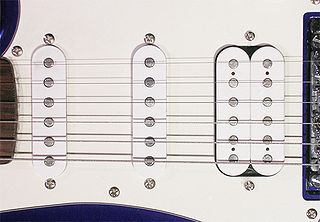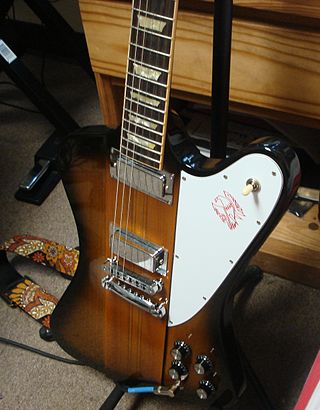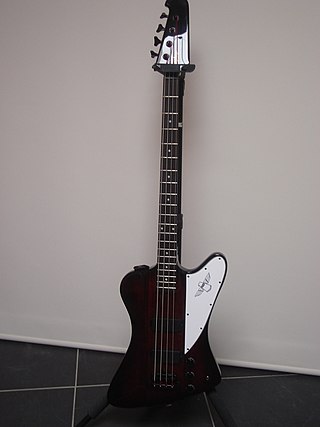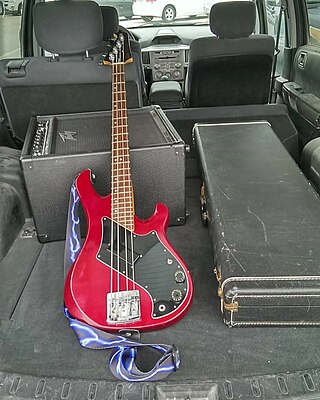Ibanez is a Japanese guitar brand owned by Hoshino Gakki. Based in Nagoya, Aichi, Japan, Hoshino Gakki were one of the first Japanese musical instrument companies to gain a significant foothold in import guitar sales in the United States and Europe, as well as the first brand of guitars to mass-produce seven-string and eight-string guitars. Ibanez manufactures effects, accessories, amps, and instruments in Japan, China, Indonesia, and the United States. As of 2017 they marketed nearly 165 models of bass guitar, 130 acoustic guitars, and more than 300 electric guitars. After Gibson and Fender, Ibanez is considered the third biggest guitar brand.

The Gibson SG is a solid-body electric guitar model introduced by Gibson in 1961, following on from the 1952 Gibson Les Paul. It remains in production today in many variations of the initial design. SG stands for "solid guitar".

The Gibson ES-335 is a semi-hollow body semi-acoustic guitar introduced by the Gibson Guitar Corporation as part of its ES series in 1958. It has a solid maple wood block running through the center of its body with hollow upper bouts and two violin-style f-holes cut into the top over the hollow chambers. Gibson has released numerous variations and models based on the ES-335.

A pickup is a transducer that captures or senses mechanical vibrations produced by musical instruments, particularly stringed instruments such as the electric guitar, and converts these to an electrical signal that is amplified using an instrument amplifier to produce musical sounds through a loudspeaker in a speaker enclosure. The signal from a pickup can also be recorded directly.

The Gibson Firebird is a solid-body electric guitar manufactured by Gibson beginning in 1963.

EMG, Inc. is the current legal name of an American company based in Santa Rosa, California that manufactures guitar pickups and EQ accessories. Among guitar and bass accessories, the company sells active humbucker pickups, such as the EMG 81, the EMG 85, the EMG 60, and the EMG 89. They also produce passive pickups such as the EMG-HZ series, which include SRO-OC1's and SC Sets. There is also a series geared towards a more traditional and passive sound known as the X series.

The Gibson Explorer is a type of electric guitar model by Gibson guitars, released in 1958. The Explorer offered a radical, "futuristic" body design, much like its siblings: the Flying V, which was released the same year, and the Moderne, which was designed in 1957 but not released until 1982. The Explorer was the final development of a prototype design that, years later, Gibson marketed under the name Futura.

The P-90 is a single coil electric guitar pickup produced by Gibson Guitar Corporation since 1946, as well as other vendors. Compared to other single coil designs, such as the Fender single coil, the bobbin for a P-90 is wider but shorter. The Fender style single coil is wound in a taller bobbin, but the wires are closer to the individual poles. This makes the P-90 produce a somewhat warmer tone with less edge and brightness, As with other single-coil pickups, the P-90 is subject to AC hum unless some form of cancellation is used.

The Gibson Thunderbird is an electric bass guitar made by Gibson and Epiphone.

The Gibson L9-S Ripper is a model of electric bass guitar made by Gibson Guitar Corporation.
The Gibson Grabber was a bass guitar introduced in 1973 along with the Gibson Ripper, both designed by Bill Lawrence.
The Gibson Les Paul bass is a bass guitar first manufactured by Gibson in 1969, just after the relaunch of the Les Paul guitar in 1968.

The Gibson Nighthawk was a family of electric guitars manufactured by Gibson. Introduced in 1993, the Nighthawk represented a radical change from traditional Gibson designs. While its maple-capped mahogany body and set neck were reminiscent of the classic Gibson Les Paul, the Nighthawk incorporated a number of characteristics more commonly associated with Fender guitars. The Nighthawk was not a commercial success; production of all models was discontinued in 1998 after only five years.
The Gibson ES series of semi-acoustic guitars are manufactured by the Gibson Guitar Corporation.

The Paul is an electric guitar made by Gibson, manufactured from 1978 to the 1980s.
The Vox Custom 24 was one of a group of guitars produced in Japan by the Matsumoku company between 1980 and 1985, which included the Custom and Standard 24 and Custom and Standard 25 guitars. Custom and Standard bass guitars were also included in the range. Matsumoku had already produced guitars for Aria and other brands such as Westbury. These were recognised as leaders in performance, innovation and quality. The electronics in these guitars were designed by Adrian Legg. The guitars are passive but the complex switching allows for a wide variety of sounds, making them extremely versatile instruments.
Jens Ritter Instruments is a manufacturer of high-end electric string instruments. It was founded by Jens Ritter in the mid-1990s and was known as Ritter Bass Guitars until 2010 when Jens expanded his line to include guitars. Jens produces 50 to 60 handmade instruments each year in his shop located in the small wine town of Deidesheim,Germany.

The Jazz Bass V is the five string (extended-range) version of the Fender Jazz Bass. It comes in several different versions, with active or passive pickups.
The Fender Telecaster, colloquially known as the tele, is an electric guitar produced by Fender. Together with its sister model the Esquire, it was the world's first mass-produced, commercially successful solid-body electric guitar. Its simple yet effective design and revolutionary sound broke ground and set trends in electric guitar manufacturing and popular music. Many prominent rock musicians have been associated with the Telecaster for use in studio recording and live performances, most notably Bruce Springsteen, Luis Alberto Spinetta, Keith Richards and George Harrison.

The Gibson Victory Bass was an electric bass guitar designed by Wayne Charvel and produced by Gibson Guitars from 1981 until 1986. It was a bass guitar variant of the Gibson Victory. It was not a successful model.














